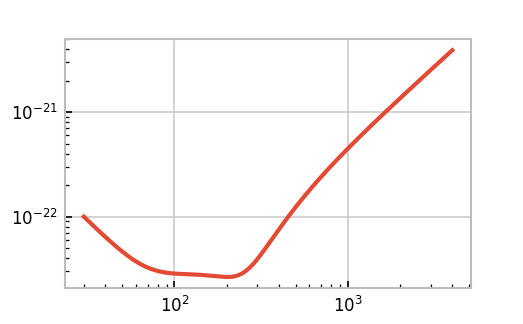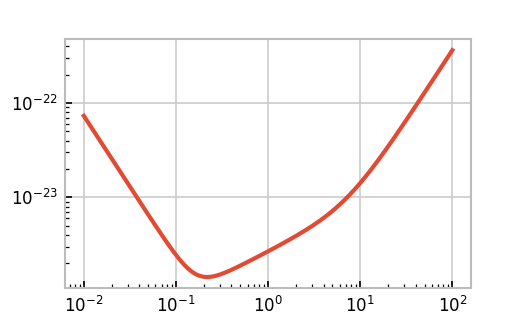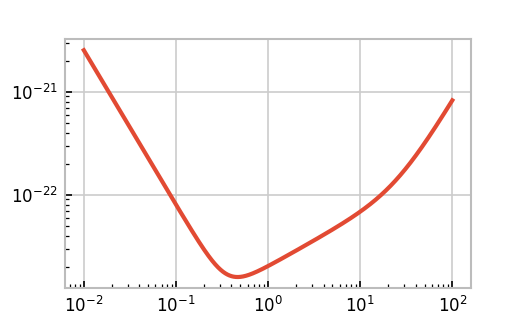Interferometers supported by gravpy¶
Ground-based detectors¶
Second-generation¶
Advanced LIGO¶
The design sensitivity noise curve for the advanced LIGO detector is available in the ifo.AdvancedLIGO class, and it can be used in a program by assigning the class to a variable:
aligo = ifo.AdvancedLIGO()
-
class
gravpy.interferometers.AdvancedLIGO(frequencies=None, configuration=None, obs_time=None)[source]¶ The advanced LIGO Interferometer.
Supported configurations are
Configuration
Description
O1
First observing run sensitivity
A+
The advanced-plus design sensitivity
See also
InitialLIGOThe initial LIGO interferometer
Examples
Specific configurations can be loaded by passing the configuration keyword argument.
>>> aligo = ifo.AdvancedLIGO(configuration="O1")
It’s straight-forward to plot the sensitivity curve for the detector at design sensitivity.
>>> import matplotlib.pyplot as plt >>> import gravpy.interferometers as ifo >>> aligo = ifo.AdvancedLIGO() >>> f, ax = plt.subplots(1) >>> aligo.plot(ax)
Which should produce an output along the lines of
(Source code, png)

- Attributes
- configurationstr, optional
A specific configuration for a given interferometer. This allows for the sensitivity from a given run to be used, or from a specific tuning.
Methods
antenna_pattern(self, theta, phi, psi)Produce the antenna pattern for a detector, given its detector tensor, and a set of angles.
energy_density(self[, frequencies])Produce the sensitivity curve of the detector in terms of the energy density.
noise_amplitude(self[, frequencies])The noise amplitude for a detector is defined as \(h^2_n(f) = f S_n(f)\) and is designed to incorporate the effect of integrating an inspiralling signal.
plot(self[, axis])Plot the noise curve for this detector.
psd(self[, frequencies])Calculate the one-sided power spectral desnity for a detector.
skymap(self[, nx, ny, psi])Produce a skymap of the antenna repsonse of the interferometer.
srpsd(self[, frequencies])The square-root of the PSD.
noise_spectrum
Advanced Virgo¶
The design sensitivity of advanced Virgo is available in gravpy using the AdvancedVirgo class.
Kagra¶
Space-based detectors¶
Millihertz¶
LISA¶
-
class
gravpy.interferometers.LISA(frequencies=None, configuration=None, obs_time=None)[source]¶ The LISA Interferometer in its mission-accepted state, as of 2018
- Attributes
- configuration
Methods
antenna_pattern(self, theta, phi, psi)Produce the antenna pattern for a detector, given its detector tensor, and a set of angles.
confusion_noise(self, frequencies[, …])The noise created by unresolvable galactic binaries at low frequencies.
energy_density(self[, frequencies])Produce the sensitivity curve of the detector in terms of the energy density.
metrology_noise(self, frequencies)Calculate the noise due to the single-link optical metrology, from arxiv:1803.01944.
noise_amplitude(self[, frequencies])The noise amplitude for a detector is defined as \(h^2_n(f) = f S_n(f)\) and is designed to incorporate the effect of integrating an inspiralling signal.
plot(self[, axis])Plot the noise curve for this detector.
psd(self, frequencies)The power spectral density.
single_mass_noise(self, frequencies)The acceleration noise for a single test mass.
skymap(self[, nx, ny, psi])Produce a skymap of the antenna repsonse of the interferometer.
srpsd(self[, frequencies])The square-root of the PSD.
eLISA¶
Deci-hertz¶
Decigo¶
-
class
gravpy.interferometers.Decigo(frequencies=None, configuration=None, obs_time=None)[source]¶ The full, original Decigo noise curve, from arxiv:1101.3940.
Examples
(Source code, png)

- Attributes
- configuration
Methods
antenna_pattern(self, theta, phi, psi)Produce the antenna pattern for a detector, given its detector tensor, and a set of angles.
energy_density(self[, frequencies])Produce the sensitivity curve of the detector in terms of the energy density.
noise_amplitude(self[, frequencies])The noise amplitude for a detector is defined as \(h^2_n(f) = f S_n(f)\) and is designed to incorporate the effect of integrating an inspiralling signal.
plot(self[, axis])Plot the noise curve for this detector.
psd(self, frequencies)The power spectrum density of the detector, taken from equation 5 of arxiv:1101.3940.
skymap(self[, nx, ny, psi])Produce a skymap of the antenna repsonse of the interferometer.
srpsd(self[, frequencies])The square-root of the PSD.
BDecigo¶
-
class
gravpy.interferometers.BDecigo(frequencies=None, configuration=None, obs_time=None)[source]¶ The B-Decigo noise curve [arxivcurve].
References
- arxivcurve
arxiv:1802.06977
Examples
(Source code, png)

- Attributes
- configuration
Methods
antenna_pattern(self, theta, phi, psi)Produce the antenna pattern for a detector, given its detector tensor, and a set of angles.
energy_density(self[, frequencies])Produce the sensitivity curve of the detector in terms of the energy density.
noise_amplitude(self[, frequencies])The noise amplitude for a detector is defined as \(h^2_n(f) = f S_n(f)\) and is designed to incorporate the effect of integrating an inspiralling signal.
plot(self[, axis])Plot the noise curve for this detector.
psd(self, frequencies)Calculate the one-sided power spectral desnity for a detector.
skymap(self[, nx, ny, psi])Produce a skymap of the antenna repsonse of the interferometer.
srpsd(self[, frequencies])The square-root of the PSD.